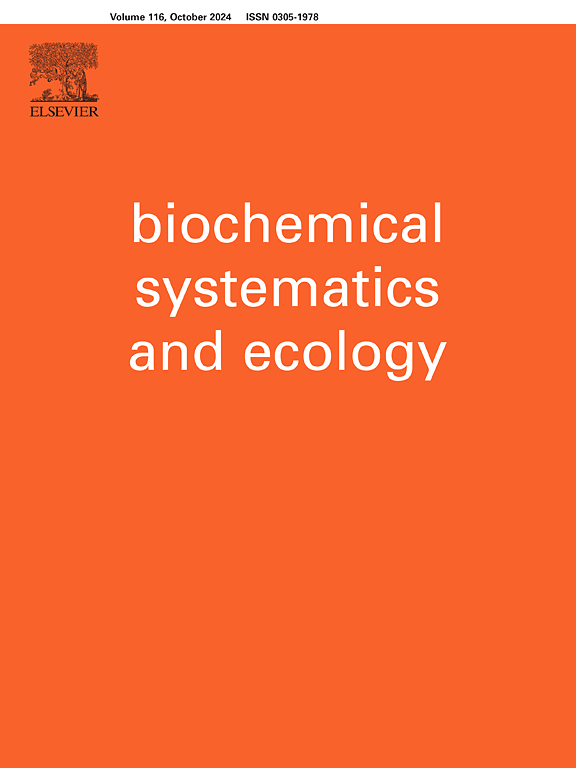Seasonal variation in chemical composition and bioactivity of Eucalyptus tereticornis leaf essential oil
IF 1.4
4区 生物学
Q4 BIOCHEMISTRY & MOLECULAR BIOLOGY
引用次数: 0
Abstract
Eucalyptus is recognized worldwide for its medicinal properties. This study aimed to evaluate the chemical composition, antifungal and antioxidant properties of essential oils (EOs) from Eucalyptus tereticornis clone C-7 during different seasons: winter, summer and rainy. EOs were obtained from leaves via hydrodistillation and their chemical composition was analyzed using gas chromatography-mass spectrometry (GC-MS). The analysis identified 77, 57 and 82 compounds in the EOs obtained during winter, summer and rainy season, respectively. The key constituents identified included isopulegol, eucalyptol, cis-sabinene hydrate, camphene, 3-carene, bicyclogermacrene and (−)globulol. Summer season EOs showed the most potent antifungal activity against the four fungal species tested: Magnaporthe grisea, Rhizoctonia solani, Rhizoctonia bataticola and Fusarium oxysporum. Furthermore, the antiradical activity by DPPH test was highest in summer season EOs, followed by rainy season EOs. The seasonal variation in the chemical composition of Eucalyptus tereticornis EOs highlights that its potential use should consider its harvesting for medicinal and nutraceutical applications.

桉树的药用价值举世公认。本研究旨在评估在不同季节(冬季、夏季和雨季)从桉树克隆 C-7 中提取的精油(EOs)的化学成分、抗真菌和抗氧化特性。精油是通过水蒸馏法从叶子中提取的,其化学成分采用气相色谱-质谱法(GC-MS)进行分析。分析结果表明,在冬季、夏季和雨季获得的桉叶油中分别含有 77、57 和 82 种化合物。鉴定出的主要成分包括异桉叶油醇、桉叶油醇、顺式芹烯水合物、莰烯、3-蒈烯、双环抱烯和(-)球醇。夏季环氧乙烷对测试的四种真菌具有最强的抗真菌活性:这四种真菌是:灰葡萄孢霉(Magnaporthe grisea)、茄根霉(Rhizoctonia solani)、蝙蝠蛾根霉(Rhizoctonia bataticola)和氧孢镰刀菌(Fusarium oxysporum)。此外,通过 DPPH 试验,夏季环氧乙烷的抗自由基活性最高,其次是雨季环氧乙烷。桉树环氧乙烷化学成分的季节性变化突出表明,其潜在用途应考虑将采收的桉树环氧乙烷用于药用和营养保健。
本文章由计算机程序翻译,如有差异,请以英文原文为准。
求助全文
约1分钟内获得全文
求助全文
来源期刊

Biochemical Systematics and Ecology
生物-进化生物学
CiteScore
3.00
自引率
12.50%
发文量
147
审稿时长
43 days
期刊介绍:
Biochemical Systematics and Ecology is devoted to the publication of original papers and reviews, both submitted and invited, in two subject areas: I) the application of biochemistry to problems relating to systematic biology of organisms (biochemical systematics); II) the role of biochemistry in interactions between organisms or between an organism and its environment (biochemical ecology).
In the Biochemical Systematics subject area, comparative studies of the distribution of (secondary) metabolites within a wider taxon (e.g. genus or family) are welcome. Comparative studies, encompassing multiple accessions of each of the taxa within their distribution are particularly encouraged. Welcome are also studies combining classical chemosystematic studies (such as comparative HPLC-MS or GC-MS investigations) with (macro-) molecular phylogenetic studies. Studies that involve the comparative use of compounds to help differentiate among species such as adulterants or substitutes that illustrate the applied use of chemosystematics are welcome. In contrast, studies solely employing macromolecular phylogenetic techniques (gene sequences, RAPD studies etc.) will be considered out of scope. Discouraged are manuscripts that report known or new compounds from a single source taxon without addressing a systematic hypothesis. Also considered out of scope are studies using outdated and hard to reproduce macromolecular techniques such as RAPDs in combination with standard chemosystematic techniques such as GC-FID and GC-MS.
 求助内容:
求助内容: 应助结果提醒方式:
应助结果提醒方式:


